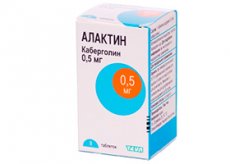Medical expert of the article
New publications
Preparations
Alactin
Last reviewed: 04.07.2025

All iLive content is medically reviewed or fact checked to ensure as much factual accuracy as possible.
We have strict sourcing guidelines and only link to reputable media sites, academic research institutions and, whenever possible, medically peer reviewed studies. Note that the numbers in parentheses ([1], [2], etc.) are clickable links to these studies.
If you feel that any of our content is inaccurate, out-of-date, or otherwise questionable, please select it and press Ctrl + Enter.

Alactin is used to slow down the processes of physiological lactation.
The active component of the drug is an ergoline derivative, which is related to the bound alkaloid of ergot and demonstrates powerful and prolonged prolactin-lowering activity (the intensity depends on the portion size). Blood prolactin levels after the administration of the drug decrease after 3 hours (on average), and the effect lasts for 14-20 days. Thus, to stop milk secretion, a single use of Alactin is enough.
Indications Alactina
It is used in the combined treatment of pituitary adenoma with the release of prolactin against its background, as well as hyperprolactinemia.
It can be prescribed to prevent or suppress the processes of physiological lactation, which begins after childbirth (in connection with medical recommendations).
Release form
The drug is released in tablets, 2 or 8 pieces per pack.
Pharmacokinetics
When administered orally, the drug is fully absorbed in the gastrointestinal tract. Food intake does not affect the absorption of cabergoline. The blood Cmax level is recorded after 3 hours.
It is synthesized with protein at a moderate level. During biotransformation, several metabolic elements are formed, but only carboxy-ergoline has medicinal activity.
The excretion period is quite long and in people with hyperprolactinemia it is 80-110 hours. It is excreted together with feces and urine.
Dosing and administration
The medicine is taken orally with food.
Suppression of postpartum lactation.
It is necessary to take 1 tablet of the drug once during the first day after delivery. The size of the therapeutic dose is 1 mg of the drug. To suppress existing lactation, it is necessary to take 0.25 mg of the drug at 12-hour intervals during the period of 2 days (the total dose is a maximum of 1 mg).
Therapy for hyperprolactinemia.
Alactin should be taken 1-2 times a week. Therapy begins with the use of lower doses of the drug - 0.25 or 0.5 mg per week. According to the indications, the dosage can be gradually increased by 0.5 mg per week with a 1-month interval, until the development of the drug effect.
The standard therapeutic dose is 1 mg per week with possible variations within 0.25-2 mg. A maximum of 3 mg of the drug can be used per day. If necessary, the weekly dose can be divided into several uses. Usually, the weekly dose is divided when using a dose over 1 mg.
Use Alactina during pregnancy
There are no adequately controlled studies of cabergoline use in pregnant women. Animal studies have shown no teratogenic effects, but there is information on embryotoxicity and decreased fertility, which are related to pharmacodynamic parameters.
There are reports of severe congenital malformations or miscarriages occurring after the use of cabergoline in pregnant women. The most common neonatal defects were musculoskeletal disorders and cardiopulmonary anomalies. There are no reports of perinatal disorders or subsequent development of children after intrauterine exposure to cabergoline.
It is necessary to make sure that there is no pregnancy before starting treatment and to monitor the possibility of its occurrence for at least another month after completion of therapy. If conception occurs during treatment, the course should be discontinued after pregnancy is diagnosed – to limit the effect of the substance on the fetus.
After stopping taking Alactin, you must continue to use contraceptives for at least another month.
Since cabergoline inhibits the lactation process, the medication is not prescribed during breastfeeding.
Cabergoline or its metabolic components were excreted in milk in rats. There are no data on excretion in human milk, but it is recommended to avoid breastfeeding if lactation is not suppressed after administration of cabergoline.
 [ 8 ]
[ 8 ]
Contraindications
Side effects Alactina
Main side effects:
- dizziness, depression, drowsiness, headaches, severe fatigue, loss of consciousness, cardiac valvulopathy and paresthesia;
- decreased blood pressure, nosebleeds, tachycardia, pain in the sternum area;
- constipation, nausea and stomach pain;
- facial hyperemia and cramps affecting the calf muscles.
Overdose
Using Alactin in large doses can cause nausea, hallucinations, stomach upset, decreased blood pressure, psychosis and vomiting.
 [ 22 ]
[ 22 ]
Interactions with other drugs
Storage conditions
Shelf life
Alactin can be used within a 3-year period from the date of manufacture of the medicinal substance.
Application for children
There is no information regarding the efficacy and safety of administering the drug to persons under 16 years of age.
 [ 26 ]
[ 26 ]
Analogues
Analogues of the drug are Dostinex, Norprolak with Bromocriptine-KV, and Bromocriptine-Richter.
 [ 27 ]
[ 27 ]
Reviews
Alactin receives very good reviews from most women.
Attention!
To simplify the perception of information, this instruction for use of the drug "Alactin" translated and presented in a special form on the basis of the official instructions for medical use of the drug. Before use read the annotation that came directly to medicines.
Description provided for informational purposes and is not a guide to self-healing. The need for this drug, the purpose of the treatment regimen, methods and dose of the drug is determined solely by the attending physician. Self-medication is dangerous for your health.

